wheel YAMAHA YZF-R6 2016 User Guide
[x] Cancel search | Manufacturer: YAMAHA, Model Year: 2016, Model line: YZF-R6, Model: YAMAHA YZF-R6 2016Pages: 112, PDF Size: 2.57 MB
Page 90 of 112

Periodic maintenance an d a djustment
6-39
6 3. Remove the burnt-out bulb by
pulling it out.
4. Insert a new bulb into the socket.
5. Install the socket (together with the bulb) by pushing it in.
6. Install the license plate light unit by installing the screws.
EAU24351
Supportin g the motorcycleSince this model is not equipped with a
centerstand, follow these precautions
when removing the front and rear
wheel or performing other mainte-
nance requiring the motorcycle to
stand upright. Check that the motorcy-
cle is in a stable and level position be-
fore starting any maintenance. A
strong wooden box can be placed un-
der the engine for added stability.
To service the front wheel
1. Stabilize the rear of the motorcy- cle by using a motorcycle stand
or, if an additional motorcycle
stand is not available, by placing a
jack under the frame in front of the
rear wheel.
2. Raise the front wheel off the ground by using a motorcycle
stand.
To service the rear wheel
Raise the rear wheel off the ground by
using a motorcycle stand or, if a motor-
cycle stand is not available, by placing a jack either under each side of the
frame in front of the rear wheel or under
each side of the swingarm.
1. License plate light bulb
2. License plate light bulb socket
1
2
U2CXE2E0.book Page 39 Tuesday, June 9, 2015 5:04 PM
Page 91 of 112
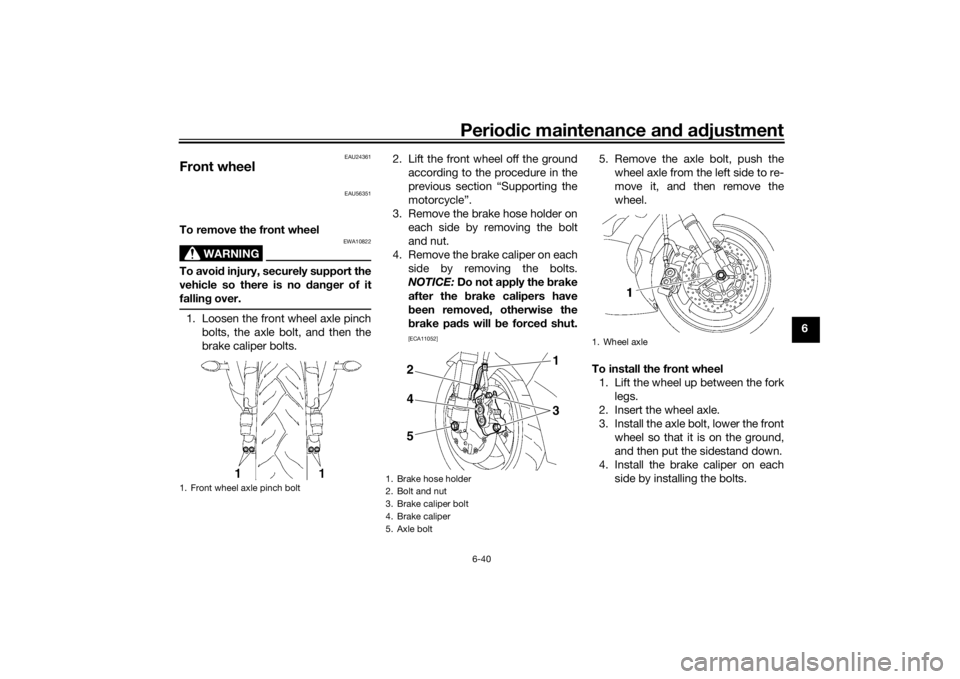
Periodic maintenance an d a djustment
6-40
6
EAU24361
Front wheel
EAU56351
To remove the front wheel
WARNING
EWA10822
To avoi d injury, securely support the
vehicle so there is no dan ger of it
fallin g over.1. Loosen the front wheel axle pinch
bolts, the axle bolt, and then the
brake caliper bolts. 2. Lift the front wheel off the ground
according to the procedure in the
previous section “Supporting the
motorcycle”.
3. Remove the brake hose holder on each side by removing the bolt
and nut.
4. Remove the brake caliper on each side by removing the bolts.
NOTICE: Do not apply the b rake
after the b rake calipers have
b een removed , otherwise the
b rake pad s will be forced shut.
[ECA11052]
5. Remove the axle bolt, push the
wheel axle from the left side to re-
move it, and then remove the
wheel.
To install the front wheel 1. Lift the wheel up between the fork legs.
2. Insert the wheel axle.
3. Install the axle bolt, lower the front wheel so that it is on the ground,
and then put the sidestand down.
4. Install the brake caliper on each side by installing the bolts.
1. Front wheel axle pinch bolt
1. Brake hose holder
2. Bolt and nut
3. Brake caliper bolt
4. Brake caliper
5. Axle bolt
31
2
4
5
1. Wheel axle
U2CXE2E0.book Page 40 Tuesday, June 9, 2015 5:04 PM
Page 92 of 112
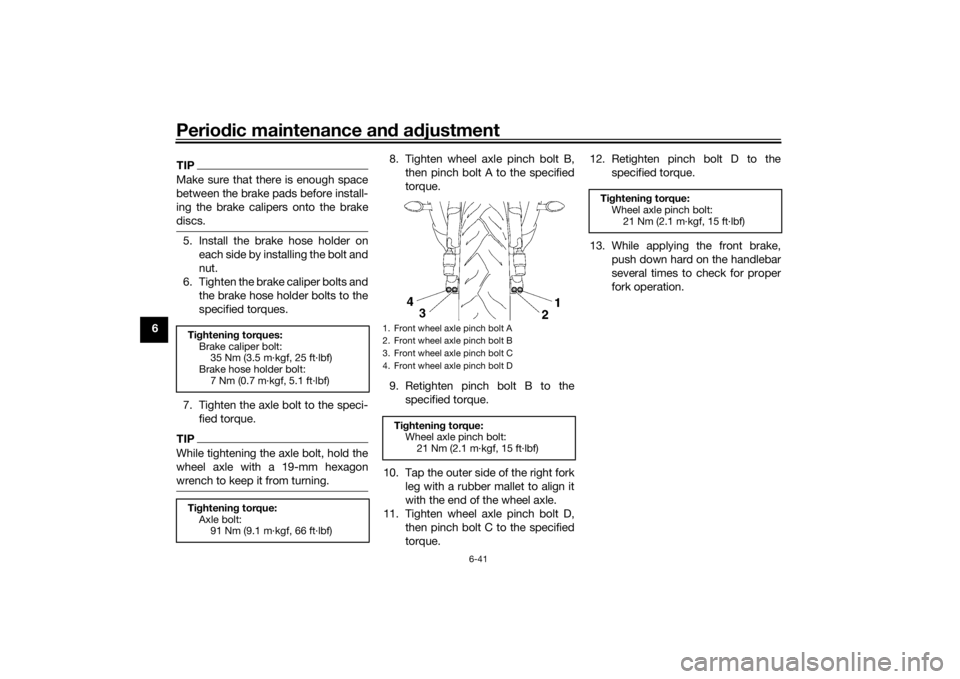
Periodic maintenance an d a djustment
6-41
6
TIPMake sure that there is enough space
between the brake pads before install-
ing the brake calipers onto the brake
discs.5. Install the brake hose holder on
each side by installing the bolt and
nut.
6. Tighten the brake caliper bolts and the brake hose holder bolts to the
specified torques.
7. Tighten the axle bolt to the speci- fied torque.TIPWhile tightening the axle bolt, hold the
wheel axle with a 19-mm hexagon
wrench to keep it from turning.
8. Tighten wheel axle pinch bolt B,then pinch bolt A to the specified
torque.
9. Retighten pinch bolt B to the specified torque.
10. Tap the outer side of the right fork leg with a rubber mallet to align it
with the end of the wheel axle.
11. Tighten wheel axle pinch bolt D, then pinch bolt C to the specified
torque. 12. Retighten pinch bolt D to the
specified torque.
13. While applying the front brake, push down hard on the handlebar
several times to check for proper
fork operation.
Tightenin g torques:
Brake caliper bolt: 35 Nm (3.5 m·kgf, 25 ft·lbf)
Brake hose holder bolt:
7 Nm (0.7 m·kgf, 5.1 ft·lbf)
Ti ghtenin g torque:
Axle bolt: 91 Nm (9.1 m·kgf, 66 ft·lbf)
1. Front wheel axle pinch bolt A
2. Front wheel axle pinch bolt B
3. Front wheel axle pinch bolt C
4. Front wheel axle pinch bolt DTightenin g torque:
Wheel axle pinch bolt: 21 Nm (2.1 m·kgf, 15 ft·lbf)
Tightenin g torque:
Wheel axle pinch bolt: 21 Nm (2.1 m·kgf, 15 ft·lbf)
U2CXE2E0.book Page 41 Tuesday, June 9, 2015 5:04 PM
Page 93 of 112
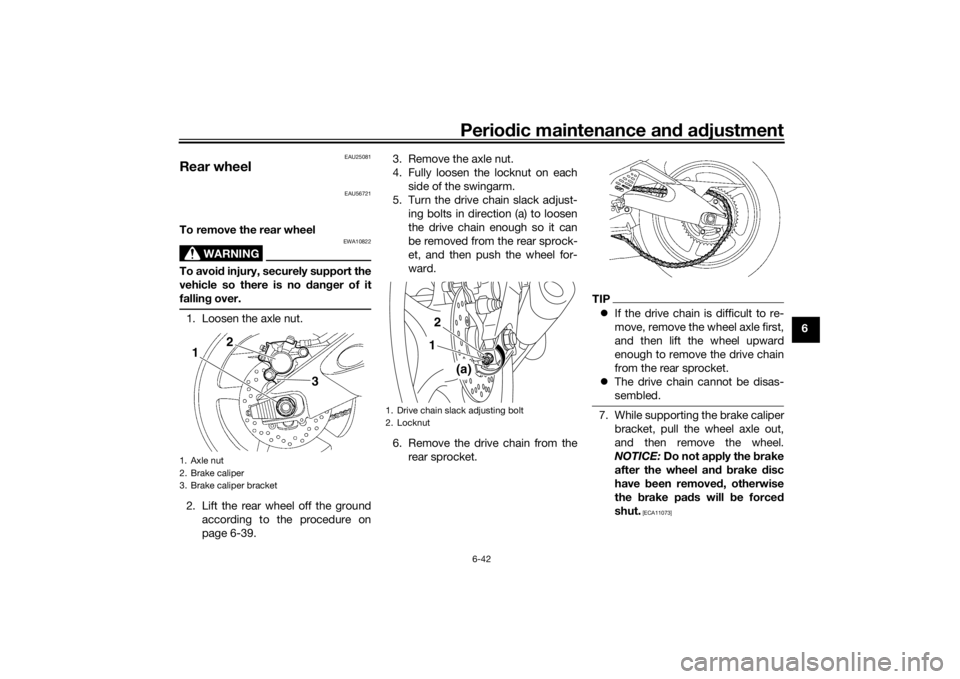
Periodic maintenance an d a djustment
6-42
6
EAU25081
Rear wheel
EAU56721
To remove the rear wheel
WARNING
EWA10822
To avoi d injury, securely support the
vehicle so there is no dan ger of it
fallin g over.1. Loosen the axle nut.
2. Lift the rear wheel off the ground
according to the procedure on
page 6-39. 3. Remove the axle nut.
4. Fully loosen the locknut on each
side of the swingarm.
5. Turn the drive chain slack adjust- ing bolts in direction (a) to loosen
the drive chain enough so it can
be removed from the rear sprock-
et, and then push the wheel for-
ward.
6. Remove the drive chain from the rear sprocket.
TIPIf the drive chain is difficult to re-
move, remove the wheel axle first,
and then lift the wheel upward
enough to remove the drive chain
from the rear sprocket.
The drive chain cannot be disas-
sembled.7. While supporting the brake caliper
bracket, pull the wheel axle out,
and then remove the wheel.
NOTICE: Do not apply the b rake
after the wheel an d b rake disc
have been removed , otherwise
the brake pad s will be forced
shut.
[ECA11073]
1. Axle nut
2. Brake caliper
3. Brake caliper bracket
1
2
3
1. Drive chain slack adjusting bolt
2. Locknut
(a)
12
U2CXE2E0.book Page 42 Tuesday, June 9, 2015 5:04 PM
Page 94 of 112
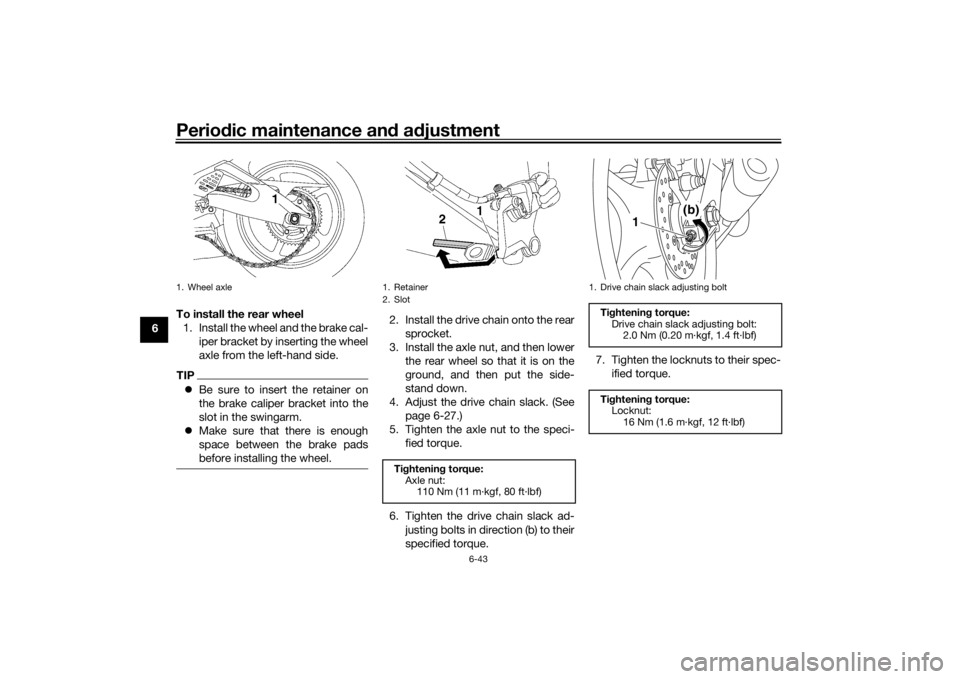
Periodic maintenance an d a djustment
6-43
6 To install the rear wheel
1. Install the wheel and the brake cal- iper bracket by inserting the wheel
axle from the left-hand side.
TIPBe sure to insert the retainer on
the brake caliper bracket into the
slot in the swingarm.
Make sure that there is enough
space between the brake pads
before installing the wheel.
2. Install the drive chain onto the rear
sprocket.
3. Install the axle nut, and then lower the rear wheel so that it is on the
ground, and then put the side-
stand down.
4. Adjust the drive chain slack. (See page 6-27.)
5. Tighten the axle nut to the speci- fied torque.
6. Tighten the drive chain slack ad- justing bolts in direction (b) to their
specified torque. 7. Tighten the locknuts to their spec-
ified torque.
1. Wheel axle
1. Retainer
2. SlotTightenin g torque:
Axle nut: 110 Nm (11 m·kgf, 80 ft·lbf)
1. Drive chain slack adjusting boltTightenin g torque:
Drive chain slack adjusting bolt: 2.0 Nm (0.20 m·kgf, 1.4 ft·lbf)
Ti ghtenin g torque:
Locknut:
16 Nm (1.6 m·kgf, 12 ft·lbf)
(b)
1
U2CXE2E0.book Page 43 Tuesday, June 9, 2015 5:04 PM
Page 98 of 112

Motorcycle care and stora ge
7-1
7
EAU37834
Matte color cautionNOTICE
ECA15193
Some mo dels are equipped with
matte colore d finishe d parts. Be
sure to consult a Yamaha d ealer for
a d vice on what prod ucts to use be-
fore cleanin g the vehicle. Usin g a
b rush, harsh chemical prod ucts or
cleanin g compoun ds when cleanin g
these parts will scratch or damag e
their surface. Wax also shoul d not
b e applied to any matte colore d fin-
ishe d parts.
EAU54721
CareWhile the open design of a motorcycle
reveals the attractiveness of the tech-
nology, it also makes it more vulnera-
ble. Rust and corrosion can develop
even if high-quality components are
used. A rusty exhaust pipe may go un-
noticed on a car, however, it detracts
from the overall appearance of a mo-
torcycle. Frequent and proper care
does not only comply with the terms of
the warranty, but it will also keep your
motorcycle looking good, extend its
life and optimize its performance.
Before cleanin g
1. Cover the muffler outlet with a plastic bag after the engine has
cooled down.
2. Make sure that all caps and cov- ers as well as all electrical cou-
plers and connectors, including
the spark plug caps, are tightly in-
stalled.
3. Remove extremely stubborn dirt, like oil burnt onto the crankcase,
with a degreasing agent and a
brush, but never apply such prod- ucts onto seals, gaskets, sprock-
ets, the drive chain and wheel
axles. Always rinse the dirt and
degreaser off with water.
Cleanin g
NOTICE
ECA11143
Avoi d using strong aci dic wheel
cleaners, especially on spoke d
wheels. If such prod ucts are
use d on har d-to-remove dirt, do
not leave the cleaner on the af-
fected area any lon ger than in-
structed . Also, thorou ghly rinse
the area off with water, imme di-
ately dry it, an d then apply a cor-
rosion protection spray.
Improper cleanin g can d amage
plastic parts (such as cowlin gs,
panels, win dshiel ds, hea dlig ht
lenses, meter lenses, etc.) an d
the mufflers. Use only a soft,
clean cloth or spon ge with wa-
ter to clean plastic. However, if
the plastic parts cannot b e thor-
ou ghly cleaned with water, di-
lute d mil d d eter gent with water
may be used . Be sure to rinse
U2CXE2E0.book Page 1 Tuesday, June 9, 2015 5:04 PM
Page 99 of 112
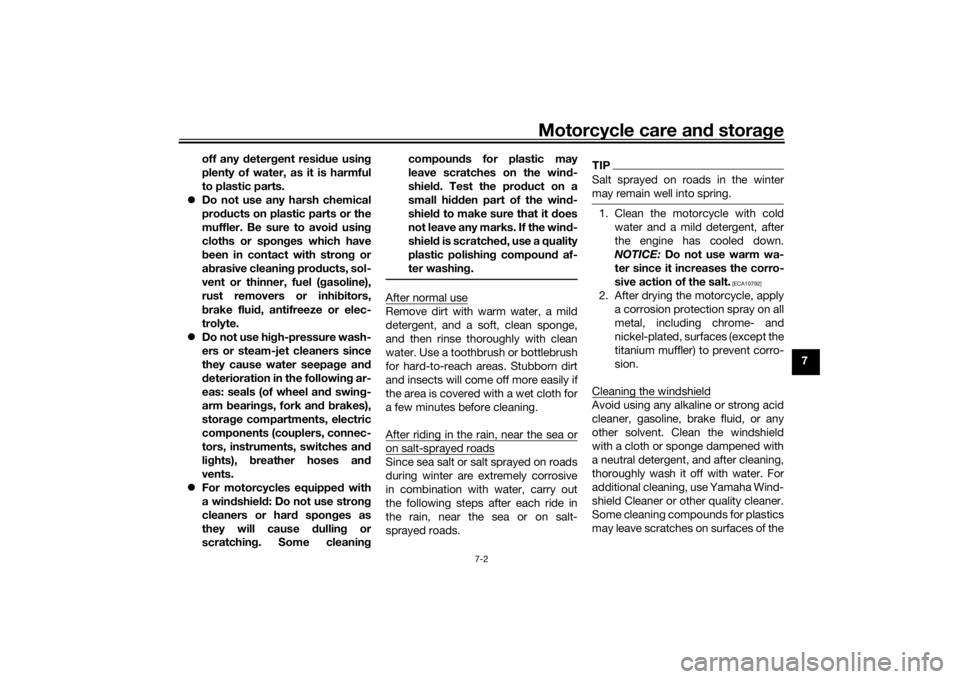
Motorcycle care and stora ge
7-2
7
off any
deter gent resi due usin g
plenty of water, as it is harmful
to plastic parts.
Do not use any harsh chemical
prod ucts on plastic parts or the
muffler. Be sure to avoi d usin g
cloths or spon ges which have
b een in contact with stron g or
a b rasive cleanin g prod ucts, sol-
vent or thinner, fuel ( gasoline),
rust removers or inhi bitors,
b rake flui d, antifreeze or elec-
trolyte.
Do not use hi gh-pressure wash-
ers or steam-jet cleaners since
they cause water seepag e and
d eterioration in the followin g ar-
eas: seals (of wheel an d swin g-
arm bearin gs, fork an d b rakes),
stora ge compartments, electric
components (couplers, connec-
tors, instruments, switches an d
li g hts), breather hoses an d
vents.
For motorcycles equippe d with
a win dshiel d: Do not use stron g
cleaners or har d spon ges as
they will cause dullin g or
sc r
atchin g. Some cleanin gcompoun
ds for plastic may
leave scratches on the win d-
shiel d. Test the pro duct on a
small hi dden part of the win d-
shiel d to make sure that it does
not leave any marks. If the win d-
shiel d is scratche d, use a quality
plastic polishin g compoun d af-
ter washing .
After normal useRemove dirt with warm water, a mild
detergent, and a soft, clean sponge,
and then rinse thoroughly with clean
water. Use a toothbrush or bottlebrush
for hard-to-reach areas. Stubborn dirt
and insects will come off more easily if
the area is covered with a wet cloth for
a few minutes before cleaning.
After riding in the rain, near the sea oron salt-sprayed roadsSince sea salt or salt sprayed on roads
during winter are extremely corrosive
in combination with water, carry out
the following steps after each ride in
the rain, near the sea or on salt-
sprayed roads.
TIPSalt sprayed on roads in the winter
may remain well into spring.1. Clean the motorcycle with cold
water and a mild detergent, after
the engine has cooled down.
NOTICE: Do not use warm wa-
ter since it increases the corro-
sive action of the salt.
[ECA10792]
2. After drying the motorcycle, apply a corrosion protection spray on all
metal, including chrome- and
nickel-plated, surfaces (except the
titanium muffler) to prevent corro-
sion.
Cleaning the windshieldAvoid using any alkaline or strong acid
cleaner, gasoline, brake fluid, or any
other solvent. Clean the windshield
with a cloth or sponge dampened with
a neutral detergent, and after cleaning,
thoroughly wash it off with water. For
additional cleaning, use Yamaha Wind-
shield Cleaner or other quality cleaner.
Some cleaning compounds for plastics
may leave scratches on surfaces of the
U2CXE2E0.book Page 2 Tuesday, June 9, 2015 5:04 PM
Page 102 of 112

Motorcycle care and stora ge
7-5
7 e. Remove the spark plug caps
from the spark plugs, and then
install the spark plugs and the
spark plug caps.
4. Lubricate all control cables and the pivoting points of all levers and
pedals as well as of the side-
stand/centerstand.
5. Check and, if necessary, correct the tire air pressure, and then lift
the motorcycle so that both of its
wheels are off the ground. Alterna-
tively, turn the wheels a little every
month in order to prevent the tires
from becoming degraded in one
spot.
6. Cover the muffler outlet with a plastic bag to prevent moisture
from entering it.
7. Remove the battery and fully char- ge it. Store it in a cool, dry place
and charge it once a month. Do
not store the battery in an exces-
sively cold or warm place [less
than 0 °C (30 °F) or more than 30
°C (90 °F)]. For more information
on storing the battery, see page
6-33.
TIPMake any necessary repairs before
storing the motorcycle.
U2CXE2E0.book Page 5 Tuesday, June 9, 2015 5:04 PM
Page 103 of 112

Specifications
8-1
8
Dimensions:Overall length:2040 mm (80.3 in)
Overall width:
705 mm (27.8 in)
Overall height: 1095 mm (43.1 in)
Seat height: 850 mm (33.5 in)
Wheelbase:
1375 mm (54.1 in)
Ground clearance: 130 mm (5.12 in)
Minimum turning radius: 3.6 m (11.81 ft)Wei ght:Curb weight:
189 kg (417 lb)Engine:Combustion cycle:
4-stroke
Cooling system: Liquid cooled
Valve train: DOHC
Cylinder arrangement:
Inline
Number of cylinders: 4-cylinder
Displacement: 599 cm³
Bore × stroke:
67.0 × 42.5 mm (2.64 × 1.67 in) Compression ratio:
13.1 : 1
Starting system: Electric starter
Lubrication system:
Wet sump
Engine oil:Recommended brand:
YAMALUBE
SAE viscosity grades:
10W-40
Recommended engine oil grade: API service SG type or higher, JASO
standard MA
Engine oil quantity: Oil change:
2.40 L (2.54 US qt, 2.11 Imp.qt)
With oil filter removal: 2.60 L (2.75 US qt, 2.29 Imp.qt)Coolant quantity:Coolant reservoir (up to the maximum level
mark):0.25 L (0.26 US qt, 0.22 Imp.qt)
Radiator (including all routes):
2.30 L (2.43 US qt, 2.02 Imp.qt)Air filter:Air filter element:Oil-coated paper elementFuel:Recommended fuel:Premium unleaded gasoline (Gasohol [E10]
acceptable)
Fuel tank capacity: 17 L (4.5 US gal, 3.7 Imp.gal) Fuel reserve amount:
3.5 L (0.92 US gal, 0.77 Imp.gal)
Fuel injection:Throttle body:
ID mark:13S1 00Spark plu g(s):Manufacturer/model:
NGK/CR10EK
Spark plug gap: 0.6–0.7 mm (0.024–0.028 in)Clutch:Clutch type:Wet, multiple-discDrivetrain:Primary reduction ratio:
2.073 (85/41)
Final drive: Chain
Secondary reduction ratio: 2.813 (45/16)
Transmission type:
Constant mesh 6-speed
Gear ratio: 1st:
2.583 (31/12)
2nd: 2.000 (32/16)
3rd: 1.667 (30/18)
4th:
1.444 (26/18)
5th: 1.286 (27/21)
U2CXE2E0.book Page 1 Tuesday, June 9, 2015 5:04 PM
Page 104 of 112

Specifications
8-2
8
6th:1.150 (23/20)
Chassis:Frame type:
Diamond
Caster angle: 24.00 °
Trail: 97 mm (3.8 in)Front tire:Type:Tubeless
Size: 120/70 ZR17M/C (58W)
Manufacturer/model:
BRIDGESTONE/BT016FF
Manufacturer/model: DUNLOP/Qualifier PTMRear tire:Type:
Tubeless
Size: 180/55 ZR17M/C (73W)
Manufacturer/model: BRIDGESTONE/BT016RF
Manufacturer/model:
DUNLOP/Qualifier PTMLoa din g:Maximum load:
186 kg (410 lb)
(Total weight of rider, passenger, cargo
and accessories)
Tire air pressure (measure d on col d
tires):Up to 90 kg (198 lb) load:
Front: 250 kPa (2.50 kgf/cm², 36 psi)
Rear:
290 kPa (2.90 kgf/cm², 42 psi)
90 kg (198 lb) load - maximum load: Front:
250 kPa (2.50 kgf/cm², 36 psi)
Rear: 290 kPa (2.90 kgf/cm², 42 psi)
High-speed riding: Front: 250 kPa (2.50 kgf/cm², 36 psi)
Rear: 290 kPa (2.90 kgf/cm², 42 psi)Front wheel:Wheel type:Cast wheel
Rim size: 17M/CxMT3.50Rear wheel:Wheel type:Cast wheel
Rim size: 17M/CxMT5.50Front brake:Type:
Hydraulic dual disc brake
Specified brake fluid: DOT 4
Rear brake:Type:
Hydraulic single disc brake
Specified brake fluid:
DOT 4Front suspension:Type:Telescopic fork
Spring:
Coil spring
Shock absorber: Hydraulic damper
Wheel travel: 115 mm (4.5 in)Rear suspension:Type:Swingarm (link suspension)
Spring: Coil spring
Shock absorber:
Gas-hydraulic damper
Wheel travel: 120 mm (4.7 in)Electrical system:System voltage:
12 V
Ignition system: TCI
Charging system: AC magnetoBattery:Model:YTZ10S
U2CXE2E0.book Page 2 Tuesday, June 9, 2015 5:04 PM